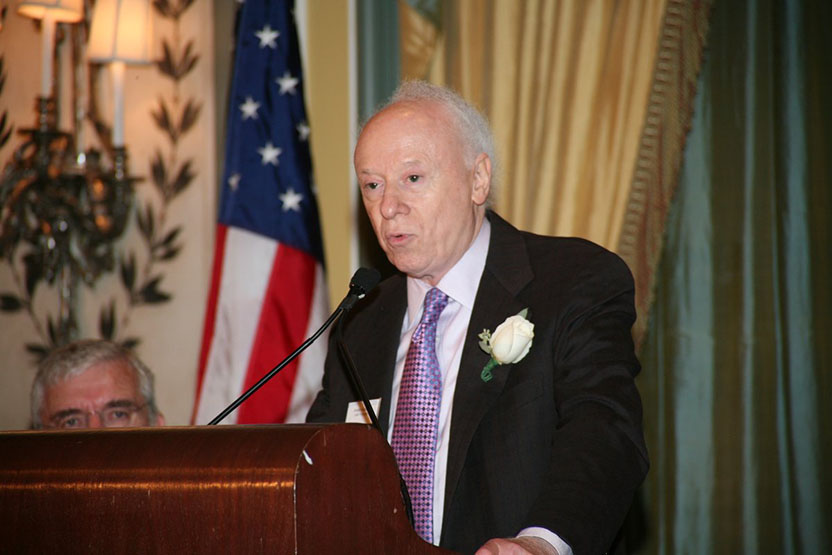Charles Babbage, the first prize recipient
The first recipient of the Royal Astronomical Society’s Gold Medal was Charles Babbage, a brilliant and eccentric professor of mathematics at Cambridge. Babbage received his medal in 1824 at age 33, the same age at which James Watson received his Nobel Prize. Babbage’s prize recognized several of his accomplishments: producing the first accurate logarithmic tables, which modernized navigation by allowing precise surveys of coasts; conceiving the first actuarial tables, which led to life insurance companies; and conceptualizing the modern postage system. Not bad, even for a 33-year-old polymathic mathematician!
Unlike many scientists who achieve success at an early age, Babbage refused to rest on his laurels. Over the next 50 years, he invented the speedometer, pioneered the art of picking locks, and relentlessly designed multiple mathematical machines for making complex calculations and breaking codes. In 1888, he designed the first programmable computer, consisting of a memory unit, a processing unit, and punch cards for giving instructions. Babbage’s now-famous ‘difference machine’, the forerunner of the modern computer, was constructed in 1991 from his original plans with funds from the Wellcome Trust and is now on display in the Science Museum in London.
To award the first prize in history to someone with the stature of a Charles Babbage sets a high standard for all prize-giving institutions, sending the clear message that the ultimate prestige and influence of a prize is determined by how well the accomplishments of its recipients advance our understanding of the natural world and stand the test of time. This is especially worth noting, as prize giving has experienced a major growth industry over the past 40 years. According to the standard reference book on the subject published by the Gale Research Company, a total of 2,228 prizes were given in 1969 in all fields of human endeavor. In 2007 the number had increased to 23,000, covering everything from A to Z — archery to zymology (prizes in zymology are given for the best homebrewed beer). Of the 23,000 prizes given today, about 1000 celebrate the biomedical sciences, and many of these biomedical awards are accompanied with a large honorarium — 15 with honoraria over $250,000 and four with honoraria over $1 million. This year, each of the three Lasker Awards comes with an honorarium of $300,000 — thanks to the generosity of Daniel Koshland, Michael DeBakey, and Eli and Edythe Broad.
Awarding prizes in science and medicine not only has become a growth industry, but is also a competitive business. Inasmuch as discoveries are often made by several individuals in different institutions, figuring out who did what and when they did it can become a frustrating and paralyzing exercise in ambiguity. So, it is not surprising that final decisions of selection committees can sometimes elicit angry responses from the spurned scientists and snide comments from the academic community. Even in those rare situations in which there is no ambiguity in pinning down who made the key discovery, selection committees are still faced with the judgmental challenge of deciding whether discovery A is more important than discovery B or C. So, every prize has its price.
The Prize Paintings of Martin Kippenberger
One of the best insights into the sociology of prizes comes from the German painter and sculptor Martin Kippenberger. Kippenberger, who was born in 1953 and died prematurely from alcoholic cirrhosis of the liver in 1997, is regarded as one of the most creative artists of his generation, often referred to as the German version of Andy Warhol. One of Kippenberger’s most provocative works that exemplifies his signature style of “exuberant unpredictability” is a metal sculpture entitled Street Lamp for Drunks, in which the lamp post is bent and curved, woozing back and forth without any human figure leaning on it.
In 1987 and 1994, Kippenberger produced two series of paintings that exploit the double meaning of the German word ‘preis’, which can be translated as ‘prize’ or ‘price’ depending on the context. In each painting, a variation of the word “preis” appears emblazoned in fat, dark letters across a colorful abstract grid of checks or plaids, resembling a tablecloth or drapes (Fig. 1).

Figure 1. Preis Bilder (Prize Paintings). This montage shows eight of the paintings from Martin Kippenberger’s Preis Bilder series of abstract paintings, in which Kippenberger exploiuble meaning of the German word ‘preis’ — ‘prize’ or ‘price’. (a-d) Four of the 14 paintings from the 1987 series: 1. Preis, 2. Preis, 5. Preis and 17. Preis. Oil on canvas, 180 x 150 cm. (e-h) Four of the five paintings from the 1994 series: 1/2 Preis, Trostpreis, Preisgünstig and Preislos. Oil on canvas, 120 x 100 cm.
In his 1987 series of Preis Bilder (Fig. 1a-d), Kippenberger titled the works to suggest awards and hierarchy: 1.Preis, 2.Preis, 3.Pries (First Prize, Second Prize, Third Prize), and so on. Most art critics called these works the Prize Paintings, but a few caught the irony and called them the Price Paintings, raising the question as to how one distinguishes a high-priced painting from a low-priced one. Is 1.Pries really more valuable in a financial sense than 5.Preis or 17.Preis?
In the 1994 series of Preis Bilder (Prize Paintings) (Fig. 1e-h), Kippenberger turned the tables in his exuberantly unpredictable way and came up with titles that are more suggestive of price than prize: 1/2 Preis (is it half-price or half of a prize?), Trostpreis (comfortable price or consolation prize?), Preisgunstig (budget price or cheap prize with a small honorarium?), and Preislos (priceless or prize-less?).
Preislos painting (Fig. 1h) is a scathing commentary on the ridiculously high prices of the art market, where the price of a painting often has no relation to its artistic value. This priceless/prize-less metaphor applies aptly to the biomedical sciences. We are all familiar with examples of priceless research that has gone prize-less in the Nobel sense — for example, Avery’s discovery that DNA is the stuff of genes, and Boyer and Cohen’s development of gene cloning. And those who serve on prize selection committees are familiar with the occasional discussion where a priceless comment from a jury member can create a prize-less situation for a nominee.
Priceless and prizeworthy research
The exuberant unpredictability of Kippenberger’s Prize Paintings is evident in the accomplishments of this year’s Lasker prize winners whose unexpected discoveries have opened new fields of basic and clinical research. As you’ll hear about after lunch, their achievements are both priceless and prizeworthy — even though (with apologies to Kippenberger) there is no single German word for such double praise.
More Jury Chair Essays








